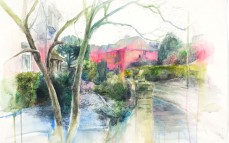The House of Fairy Tales has flown through time and space and all 15 dimensions to take up residency on the Stanley Picker Gallery Island, as part of a programme of events and exhibitions happening across the Borough of Kingston throughout February and March for Histories in the Making: Celebrating 140 years of Kingston School of Art.
During their residency the Characters, Philosophers and Boffins of this universe-famous space-ship have inspired, cajoled and google-blasted the students of Kingston University into making a series of curious museums and exquisite troves of learning. These are receptacles, coffers and cases of whimsy and miniature worlds, caskets of jewel-bright objects, models and artefact and moving new-streams of fabulous, fascinating ideas and information, surreal and poetic treasures guaranteed to inspire the youngest and the oldest of minds. Each Trove will be a living 3-dimensional mood-board of inspiration and creative innovation: a giant Lilliputian collaboration with a thousand authors.
Let your imagination run riot in The Misplaced Museum! Investigate the clues and the mysteries of the dream world from the sleepwalking detectives at The Somnambulant Detective Bureau, conjured up by the brains of Oliver Wallace, MA History of Art and MA Creative Practice students.
Discover the power of light at the workshop bench of Olaf The Lofty an eccentric inventor, designed by Mark Bayley. Be beguiled by The Mouse House, a living sculpture by artist Dmitri Galitzine, which has travelled in all 15 dimensions the House of Fairy Tales for the past 6 years.
Feast your eyes upon the marvellous automata pieces. With exhibits from Keith Newstead, Ron Ruller, Peter Markey, Fi Hensall and Matt Smith and enter through the secret wardrobe to immerse yourself in the magical crochet world of recycled rubbish, crafted by Anna Kompanients and crochet plastic-eers from Foundation Diploma and BA Fine Art.
The House of Fairy Tales residency was preceded by a ‘Take-Over Day’ where the children of Kingston and beyond descended upon the Faculty of Art, Design & Architecture to follow a magical trail around this inside-outside building and its very special Gallery on the island round the back. The culmination of this day of thinking-through-making swarmed, all knowledge, like busy bees, onto the Stanley Picker Gallery Island where the experiment continues for the eight weeks of the exhibition.
The House of Fairy Tales is a National Children’s Arts Charity established in 2006 by Kingston Alumni Gavin Turk and Deborah Curtis to inspire creativity and imagination in children and their families.
Associated Events:
Gallery Breakfast Club: Sat 14 Feb 11am-1pm
An opportunity for visitors of all ages to meet Gallery staff for coffee, juice and a pastry (if you get here early enough!) to look around our current exhibition and find out about our upcoming programme. Includes creative activities for children.
The Somnambulant Detective Agency is Open!
Tues 17 Feb 2-4pm, Wed 25 Feb 3-4pm & Wed 4 Mar 1-2pm & 4-5pm
Join The House of Fairy Tales Somnambulant Detectives on a journey through time, space and The Misplaced Museum. Interactive Performance for ages 5 to Adult
Meet up with Fellow Terrestrials: Wed 18 Feb 5-7pm
Join members of local Meetup groups for conversation, refreshments and shared exploration of The Misplaced Museum. All Welcome
Lunchtime Talk + Evening Salon with Deborah Curtis: Wed 25 Feb 1pm /5-7pm
Take a trip into all 15 dimensions to talk about the serious art of play to inspire creativity and imagination in children and adults. All Welcome
Report for The HoFT Examiner: Sat 14 Mar 11am-5pm
You are invited to investigate and report for The House of Fairy Tales Newspaper, The HoFT Examiner with artist Vicky Willmott. All Welcome / Drop-in Anytime
Lobby Display – peek into the Time Capsule: Launch Tues 17 March 5-7pm / Open until 21 March
A showcase of new work made by local residents and school children which has been inspired The Misplaced Museum and the vibrant history of Kingston School of Art – part, present and future! All Welcome
All Event Enquiries: n.kay@kingston.ac.uk / 020 8417 4074





 To accompany her exhibition Laura Grace Ford has produced the very first of our Stanley Picker Gallery Editions, specially created to directly support our programme of activities and the artists and designers we work with. This colour lithograph, on Saunders Waterford paper, entitled Abiding by Rituals (signed-edition of 50 copies) is available exclusively for sale from the Gallery priced £145 (+ VAT). See full image above and contact the Gallery to receive further details.
To accompany her exhibition Laura Grace Ford has produced the very first of our Stanley Picker Gallery Editions, specially created to directly support our programme of activities and the artists and designers we work with. This colour lithograph, on Saunders Waterford paper, entitled Abiding by Rituals (signed-edition of 50 copies) is available exclusively for sale from the Gallery priced £145 (+ VAT). See full image above and contact the Gallery to receive further details.